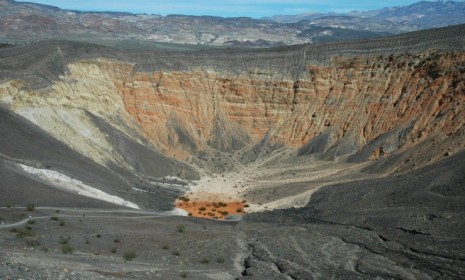Could volcanoes erupt in California?
The Ubehebe Crater in Death Valley isn't nearly as dormant as experts long believed — meaning it might just be "ripe for an eruption"

Bad news, Californians. A long-dormant volcano in Death Valley National Park might be due for an eruption far sooner than originally anticipated, according to researchers from Columbia University. Is the Golden State really in danger of blowing its lid? Here's what you should know:
Which volcano is it?
It's the Ubehebe Crater, which sits in the northern region of Death Valley. The mile-and-a-half-wide, 600-foot-deep crater was thought to have come "explosively into being" some 10,000 years ago when rising magma came into contact with sea water, says Richard A. Lovett at National Geographic. "The bomb-like steam eruption produced a mushroom cloud that, as it collapsed, sent rocky debris flowing out sideways at 200 miles an hour." But new research suggests the volcano is much younger than that.
The Week
Escape your echo chamber. Get the facts behind the news, plus analysis from multiple perspectives.

Sign up for The Week's Free Newsletters
From our morning news briefing to a weekly Good News Newsletter, get the best of The Week delivered directly to your inbox.
From our morning news briefing to a weekly Good News Newsletter, get the best of The Week delivered directly to your inbox.
How old is it then?
The last explosion happened just 800 years ago, says Jesus Diaz at Gizmodo — a far cry from original estimates. A team of scientists, including study co-authors Peri Sasnett and Brent Goehring, used "the same method used to date moon rocks" to get a reading on the crater's real age after seeing it firsthand and questioning the time since its last eruption. "It looks very young," said Goehring.
Why does the volcano's age matter?
"According to the new data, the eruption was recent enough to suggest that the area might become volcanically active again," says Lovett, meaning "the conditions are still ripe for an eruption." For the crater to blow, it would require a pressurized combination of magma and water, much like the conditions that originally set it off. This combination "produces steam," says Diaz, "which in turn results in a pressure build-up until it reaches a point that will cause a violent explosion."
A free daily email with the biggest news stories of the day – and the best features from TheWeek.com
But where would the water come from? Isn't Death Valley dry?
For the most part it is. But "you need about a hundred Olympic-size swimming pools to generate enough steam to [produce] Ubehebe Crater," Goehring says, and there's probably more than that underneath the crater today, as evidenced by nearby springs. That means, says Eric Klemetti at Wired, that the conditions required for an eruption "are likely still present in eastern California."
How bad would an eruption be?
"Luckily," the Ubehebe Crater wouldn't explode without warning, says Lovett. Most likely, experts would be tipped off by hydrothermal or seismic activity, and park rangers aren't too concerned at the moment. But if the volcano were to explode, the eruption would be "spectacular" — though not big enough to cause any damage to nearby cities.
Sources: Gizmodo, National Geographic, Wired
-
 The curious history of hanging coffins
The curious history of hanging coffinsUnder The Radar Ancient societies in southern China pegged coffins into high cliffsides in burial ritual linked to good fortune
-
 The Trump administration says it deports dangerous criminals. ICE data tells a different story.
The Trump administration says it deports dangerous criminals. ICE data tells a different story.IN THE SPOTLIGHT Arrest data points to an inconvenient truth for the White House’s ongoing deportation agenda
-
 Ex-FBI agents sue Patel over protest firing
Ex-FBI agents sue Patel over protest firingspeed read The former FBI agents were fired for kneeling during a 2020 racial justice protest for ‘apolitical tactical reasons’